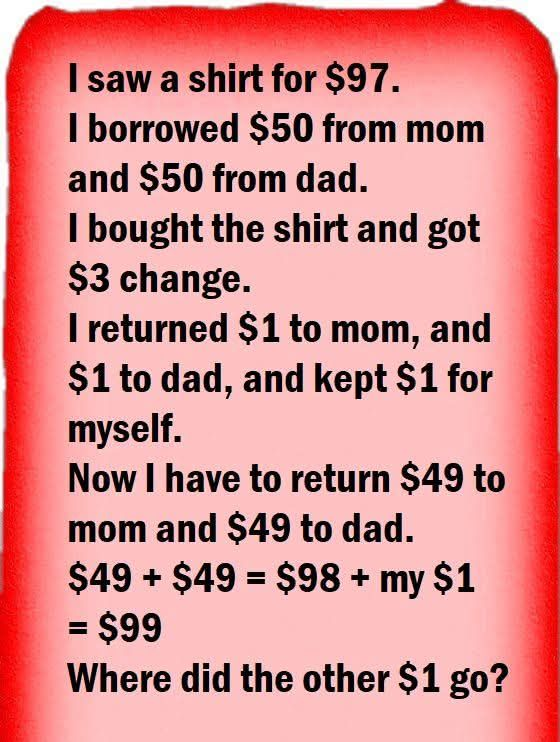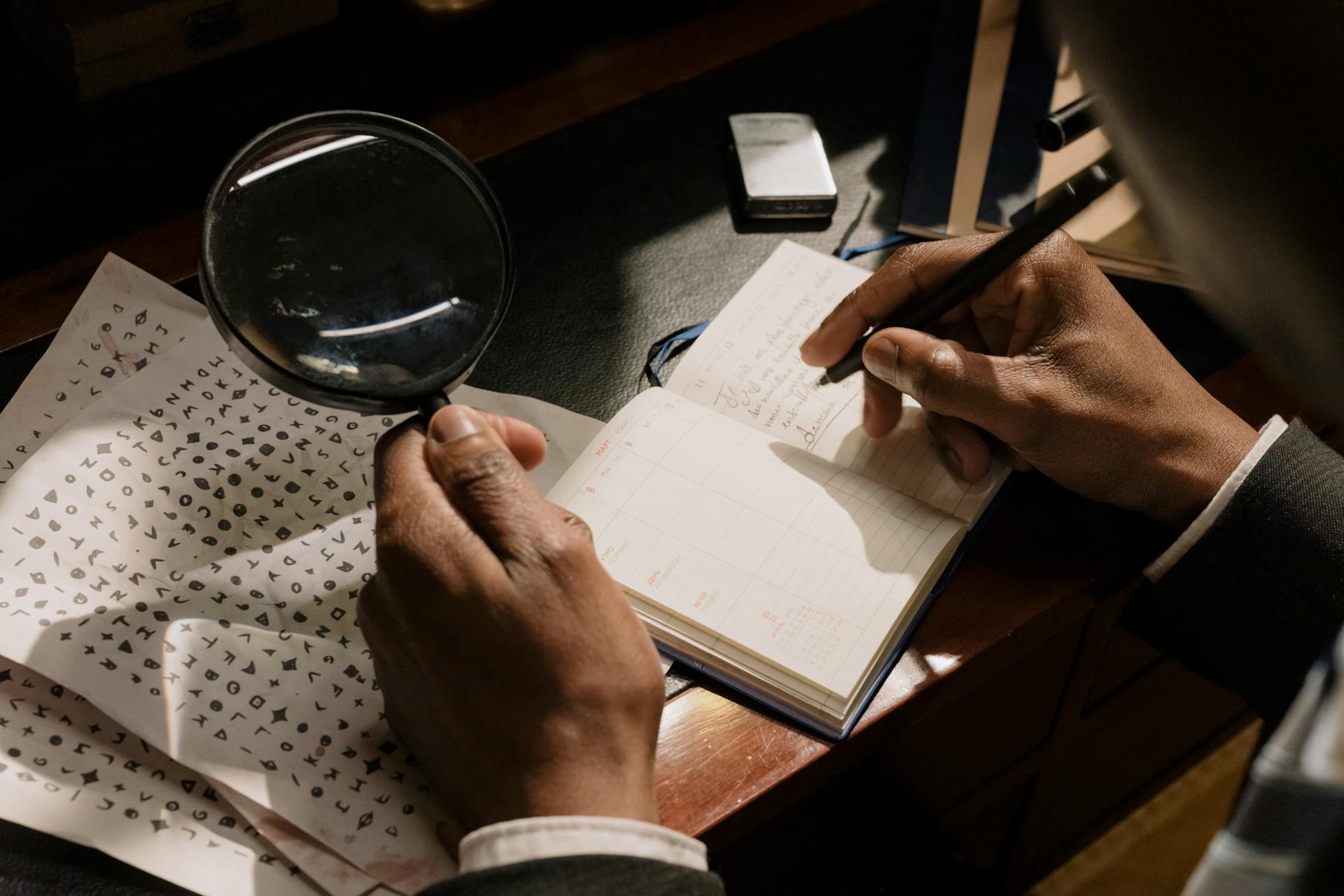Some puzzles are designed to trick your brain into thinking in ways that don’t quite align with logic. One such puzzle is the “Missing Dollar Riddle,” which has confused countless people over the years. At first glance, it appears that a dollar has mysteriously vanished, leaving everyone scratching their heads. But when you break it down logically, you’ll realize there’s no mystery at all!
Let’s dive into this brain teaser, analyze the common mistakes people make when solving it, and uncover the real solution behind the so-called missing dollar.
Can You Find the Missing Dollar?

Here’s how the puzzle goes:
- You see a shirt for $97.
- You borrow $50 from your mom and $50 from your dad, giving you $100 in total.
- You buy the shirt for $97, leaving you with $3 in change.
- You return $1 to your mom and $1 to your dad, and keep $1 for yourself.
- Now, you owe your parents $49 each, for a total debt of $98.
- But if you add the $1 you kept, you get $99.
Where did the other $1 go?
This riddle creates an illusion that $1 has gone missing, but let’s break it down logically and understand why this is a trick of wording rather than an actual mathematical problem.
Why Do People Get It Wrong?
Many people fall for this riddle because of a simple misdirection in arithmetic. The puzzle tricks your brain by making unrelated numbers appear connected, leading you to believe something is missing. Here are the main errors in thinking:
- Adding Instead of Accounting for Debt
- The mistake happens when you add the $1 you kept to the $98 debt, instead of realizing that the $98 already accounts for the $1.
- The real calculation should not involve adding your kept dollar to your remaining debt.
- Misleading Framing
- The wording makes it seem like you need to account for $100, when in reality, you only spent $97 and kept $3 in change.
- You already paid back $2 to your parents, so you are only left with the real debt of $98.
- Grouping Numbers Incorrectly
- The puzzle misleads people by presenting numbers in a way that suggests an imbalance.
- In reality, all the numbers add up correctly, but the way they are framed creates a false perception of a missing dollar.
Video : Stolen $100 Puzzle || $100 Puzzle Answers
Now, let’s solve the riddle correctly step by step.
Breaking Down the Puzzle Step by Step
Step 1: Understanding the Money Flow
- You borrowed $100.
- You spent $97 on the shirt.
- You got $3 in change.
Step 2: Paying Back Your Parents
- You returned $1 to mom and $1 to dad.
- That means you paid back a total of $2, leaving you with $98 of remaining debt.
- You kept $1 for yourself.
Step 3: Understanding the Real Math
- The $98 you owe includes the $97 for the shirt and the $1 you kept.
- The mistake in the riddle is adding the $1 instead of recognizing it as part of the $98 balance.
Step 4: The Correct Breakdown
Instead of thinking $98 + $1, you should recognize:
- $97 went to the store for the shirt.
- $2 went back to your parents.
- $1 stayed with you.
So, there is no missing dollar!
Why This Puzzle Works as a Brain Teaser
This riddle is a perfect example of how misdirection can trick the mind into thinking something is missing when everything actually adds up. It highlights the importance of logical reasoning and proper number association.
People often try to fit numbers into a pattern without checking if the calculations actually make sense. The real issue is the way the problem is framed, rather than an actual discrepancy in the numbers.
How to Improve Your Logical Thinking with Riddles Like This
If you enjoy puzzles like this, here are some ways to sharpen your problem-solving skills:
1. Always Question the Framing
Before assuming something is wrong, ask yourself: Am I looking at the numbers correctly? Sometimes, puzzles use misleading language to make you group unrelated figures together.
2. Break Down Each Step Clearly
Writing out each step, like we did in this article, helps clarify the logic behind a problem. This method makes it easier to spot errors in reasoning.
3. Check Your Assumptions
In this puzzle, we assumed that the debt ($98) and the $1 kept were separate, when in reality, the $1 kept was already included in the $98. Always double-check if your assumptions align with basic math principles.
4. Practice with Similar Puzzles
The best way to improve your logic skills is to practice puzzles that challenge your assumptions. Try solving classic riddles like:
- The Two Missing Dollar Puzzle
- The Hotel Room Overcharge Mystery
- The Monty Hall Problem
Video : The Missing Dollar Mystery!
Each of these requires you to rethink how you view numbers and logic.
Final Thoughts: There Was Never a Missing Dollar!
The Missing Dollar Riddle is a clever wordplay trick rather than a genuine mathematical mystery. By misdirecting your focus, it makes you believe that something has disappeared when, in reality, everything adds up perfectly.
Understanding this puzzle teaches an important lesson: always check the logic behind numbers before assuming something is missing. Sometimes, the real trick isn’t about a missing dollar—it’s about how your mind processes information!
Now that you know the solution, did you fall for the trick at first? Let us know in the comments if you figured it out quickly or if this riddle had you second-guessing your math skills!
During the Divorce My Husband Gave My Fur Baby to an Animal Shelter, Unaware It Would Leave Him Penniless

When my husband dumped my golden retriever, Bailey, at a shelter during our divorce, I was devastated. Little did he know, that cruel act would cost him dearly and unravel his carefully-hidden secrets.
Bailey wasn’t just a dog. She was my family, my lifeline through the storm of my marriage’s collapse. And when Adam tried to take her from me, he unleashed a chain of events he could never have seen coming.

A woman standing in her house | Source: Midjourney
Marriage is supposed to be a partnership, a bond where both people lift each other up. But with Adam, it felt like I was carrying the weight of two people. And his greed made it heavier every day.
When we first met, Adam was everything I thought I wanted. He was charming, thoughtful, and attentive. He even acted like he loved my dog, Bailey.
But once we were married, the cracks began to show.

A man sitting on a couch | Source: Midjourney
At first, they were small things like refusing to pitch in for groceries, brushing off household chores, and grumbling about expenses for Bailey’s vet bills. But as time went on, his true nature revealed itself.
He was more interested in hoarding money than building a life together.
“Adam, Bailey needs her vaccinations,” I said one evening, holding a bill from the vet.
“Do we really need to spend so much on a dog?” he replied, barely looking up from his laptop.
“She’s not just a dog,” I shot back. “She’s family.”

A close-up shot of a dog | Source: Pexels
“She’s your dog, Eliza,” he shrugged. “Not mine!”
That was Adam. Generous with words when he wanted something, but stingy with anything that required real effort.
When I filed for divorce, I thought I’d finally be free of his manipulative ways. But Adam wasn’t done being vindictive.
During the proceedings, he kicked me out of the house. The same place I’d helped maintain for years. And he even refused to let me take Bailey.

A man standing outside his house | Source: Midjourney
“PLEASE, GIVE ME BACK MY DOG!” I pleaded. “SHE’S MINE! SHE’S MY FAMILY!”
“I don’t care,” he said.
“You can’t keep her,” I cried. “She’s been with me since before we got married! This isn’t fair!”
“Too bad,” he said coldly. “She’s on my property now.”
I begged him to reconsider, but his heart was as cold as stone.
I couldn’t believe this was the same man who’d helped me take Bailey to the vet when I found her on the street. I remember everything about that night very well.
The night that changed my life and introduced me to Adam.

View from inside a car on a rainy night | Source: Pexels
The rain poured in sheets, soaking everything in sight as I hurried through the park on my way home. Then I heard it: a faint whimper.
I stopped, squinting through the downpour, and saw a small, trembling figure under a bench.
“Oh my God,” I whispered, crouching down.
A tiny golden retriever puppy, drenched and shivering, stared up at me with pleading eyes.
“Hey, sweetheart,” I murmured, gently scooping her up.
Her body was cold and frail, and my heart broke for her. I didn’t know what to do. I stood there in the rain with no idea how to help her.
That’s when Adam appeared.

A man standing in the rain | Source: Midjourney
“Need some help?” a voice called out, startling me.
I turned to see a man jogging toward me, holding an umbrella. His hair was plastered to his forehead from the rain, but he smiled warmly, his gaze flicking to the puppy in my arms.
“She’s freezing,” I said, my voice shaky. “I don’t know where to take her.”
Adam didn’t hesitate. “Come on, let’s get her to a vet. My car’s just over there.”
I hesitated for a moment, but the urgency of the situation and his kind demeanor convinced me.
“Okay,” I whispered. “Thank you.”

A woman standing in the rain | Source: Midjourney
He held the umbrella over us as we ran to his car, where I carefully settled the puppy on my lap.
During the drive, Adam chatted to calm my nerves, asking about the puppy and where I’d found her.
At the vet clinic, we worked together to get Bailey the care she needed. The vet examined her and gave her some warm blankets.
“She’s malnourished, but nothing a bit of love and care won’t fix,” the vet reassured us.

A puppy | Source: Pexels
Adam turned to me with a grin. “Looks like you’ve got yourself a new friend.”
I smiled back, relieved. “I think you’re right.”
After the visit, Adam drove me home. As we pulled up to my apartment, he turned to me and said, “If you need anything for her like supplies, advice, or anything else… just give me a call, okay?”
He handed me his number, and I thanked him for his help.
Over the next few weeks, Adam and I stayed in touch.

A woman using her phone | Source: Pexels
He checked in on Bailey, offering tips on puppy care and even stopping by to drop off supplies. It didn’t take long for our friendship to grow into something more.
When we started dating, he made it clear he adored Bailey. Or at least that’s what I thought.
He played fetch with her, snapped photos, and even talked about how much fun it would be to have a family someday. I was smitten, both with him and the idea of building a life together.
We got married the following year.

A couple holding hands on their big day | Source: Pexels
I moved into his house with Bailey, thinking I’d found my happily ever after. At first, everything seemed perfect. But as the months passed, I started noticing cracks in Adam’s charming facade.
With time, I realized he was not the man he’d pretended to be.
It’s not like I didn’t try to save our marriage. I did. I confronted him so many times, and he’d make empty promises to change, but nothing ever improved.
By the time I filed for divorce, I was emotionally drained. Leaving felt like my only option.

A woman standing with her hand on her head | Source: Pexels
And then he kicked me out, refusing to give Bailey back to me. What I didn’t know was that he’d already decided to get rid of her.
He took Bailey to a shelter and dropped her there. I couldn’t believe it when he told me that.
“How could you do this?” I yelled at him over the phone. “Are you being for real, Adam?”
He just laughed and hung up, unaware of how he’d soon regret his decision.

A man holding his phone | Source: Pexels
Over the next few days, I couldn’t stop picturing her curled up in a corner, wondering why I wasn’t there. I made it my mission to find my little girl, no matter what I had to go through.
I scoured every animal shelter within a hundred miles, calling, emailing, and visiting in person, armed with pictures of her sweet golden face.
Each day without her felt like another layer of heartbreak, but I refused to give up. When it became clear that the search was beyond my reach, I hired a private investigator, John.

A man taking notes | Source: Pexels
“Lost pets aren’t my usual line of work,” he said when we first met. “But I’ve got a soft spot for dogs. I’ll find her for you.”
Weeks stretched into what felt like an eternity. I tried to stay hopeful, but each passing day without news felt heavier than the last. Then, one day, my phone rang.
“Ma’am,” John said, “I found your dog!”
My breath caught. “You… you found her? Where is she?”

A woman talking on the phone | Source: Midjourney
“She’s safe, but that’s not all,” he continued. “There are some facts that will help you win this divorce and leave your husband with nothing. Listen to me carefully.”
I gripped the phone tightly, my heart racing.
He outlined his plan to help me get Bailey back and hinted at something much bigger brewing beneath the surface. But for now, his focus was on reuniting me with my fur baby.

A dog sitting near water | Source: Pexels
“The shelter’s an hour away,” he said. “They have her on record, but she’s been adopted. You’ll need to talk to them to get the details on the new owners.”
I didn’t waste a second. Grabbing my keys, I drove straight to the shelter, hope and anxiety swirling inside me.
When I arrived, the woman at the front desk handed me a file. Inside was a photo of Bailey, her soulful eyes staring back at me.

A woman looking at a photo | Source: Midjourney
“She was adopted last week by a couple,” the woman explained. “We can’t give you their address, but we can pass along a message if you’d like.”
“Please,” I said, my voice trembling. “Tell them I’d like to meet and explain everything.”
A few days later, I got a call from the couple. They agreed to meet me at a coffee shop, and when I arrived, my nerves were in overdrive.

A cup of coffee on a table | Source: Pexels
Sitting across from them, I poured out my story, my voice breaking as I recounted how Bailey had come into my life and how much she meant to me.
“She’s not just a dog,” I said, tears pooling in my eyes. “She’s my family.”
The couple listened intently, glancing at each other with knowing looks. Finally, the woman reached across the table and touched my hand.
“We can see how much you love her,” she said softly. “And as much as we’ve grown attached to her, we know she belongs with you.”

A woman talking to another woman in a coffee shop | Source: Midjourney
I was speechless. Gratitude and relief washed over me as they handed over Bailey’s leash and paperwork.
When I reunited with Bailey, her tail wagged furiously, and she barked as if to say, “What took you so long?”
I hugged her tightly, promising her that she’d never feel abandoned again.
But the surprises didn’t stop there.
During my phone call with John, he told me he’d uncovered a gold mine of deceit after digging into Adam’s finances.

A stack of coins | Source: Pexels
Turns out, Adam had been hiding assets during the divorce, including a luxury home he’d purchased under his mother’s name to keep it off the marital records.
I hired an accountant to review his financials, and the findings were damning. The down payment for the house came from our joint marital account, and the mortgage was being paid from our marital funds.
When we submitted all the documents and facts to the court, my husband called. “JUST LEAVE ME ALONE! Let me live my life!” he spat. But I didn’t listen to him. I just told him that I had turned on the voice recorder on my phone and he hung up.

A woman standing in a court | Source: Midjourney
The judge didn’t take kindly to his attempts at deception. He was penalized heavily, and I was awarded a significant portion of the house’s value.
Guess what did I do with the settlement? I bought a cozy little house with a big yard for Bailey.
She now spends her days chasing squirrels and rolling in the grass, while I just look at her with pride and gratitude.
Every night, as she curls up beside me, her steady breathing reminds me of what truly matters. Even when life unravels, love and a little resilience can stitch it back together stronger than before.

A woman with her dog | Source: Midjourney
If you enjoyed reading this story, here’s another one you might like: When Claire’s husband of eight years accidentally sends her a screenshot exposing his affair, her world shatters. But instead of crumbling, she teams up with an unlikely ally, his mistress, Mia. Together, they orchestrate the ultimate revenge…
This work is inspired by real events and people, but it has been fictionalized for creative purposes. Names, characters, and details have been changed to protect privacy and enhance the narrative. Any resemblance to actual persons, living or dead, or actual events is purely coincidental and not intended by the author.
The author and publisher make no claims to the accuracy of events or the portrayal of characters and are not liable for any misinterpretation. This story is provided “as is,” and any opinions expressed are those of the characters and do not reflect the views of the author or publisher.



Leave a Reply